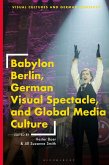The Tales of Hoffmann (1951) is a unique and important film, both in the history of British cinema and in the history of interdisciplinary art-making. It is the first full-throttle presentation of an opera on screen: a Technicolor exploration of romance, fantasy, and failure, more danced than sung.
Like the best in the BFI Film Classics series, William Germano's study is at once brisk and lush. The book's virtues include how vividly it establishes a context for understanding its subject, a context that includes the opera on which the film is based; the stories on which the opera is based; other films by Powell and Pressburger (most crucially The Red Shoes); other films, from the silent Waxworks to George Romero's zombie cycle; live opera (and here Germano's knowledge is especially deep and illuminating); and painting. The book ranges widely but it also plunges deeply into an engrossing, moment-by-moment descriptive analysis of Powell and Pressburger's film. Here the interdisciplinary approach the author takes infuses his close consideration of such cinematic techniques as camera movements, off-screen space, and editing. Through his intent focus on one film, Germano has produced a rich, tightly circumscribed meditation on much broader subjects, from the nature of cinema to the nature of opera to what happens when the two are interfused in Powell and Pressburger's unique cinematic reworking-and transposition into spatial terms-of the essentially vocal material that is their source. Coupled with the Criterion DVD, Germano's book provides a rare opportunity for a concentrated, sensuous, and intellectual excursion into one of the stranger and more hallucinatory territories ever mapped out on film. Case Western Reserve University Professor Rob Spandoni









